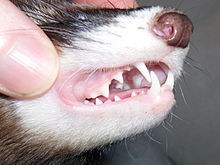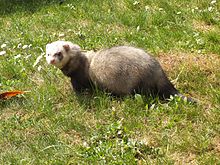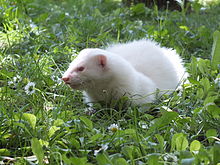Several other Mustelids also have the word ferret in their common names, including an endangered species, the black-footed ferret.
The history of the ferret's domestication is uncertain, like that of most other domestic animals, but it is likely that ferrets have been domesticated for at least 2,500 years. They are still used for hunting rabbits in some parts of the world, but increasingly, they are kept only as pets.
Being so closely related to polecats, ferrets easily hybridize with them, and this has occasionally resulted in feral colonies of polecat-ferret hybrids that have caused damage to native fauna, especially in New Zealand.[3] As a result, some parts of the world have imposed restrictions on the keeping of ferrets.

Etymology
The name "ferret" is derived from the Latin furittus, meaning "little thief", a likely reference to the common ferret penchant for secreting away small items.[4] The Greek word ictis occurs in a play written by Aristophanes, The Acharnians, in 425 BC. Whether this was a reference to ferrets, polecats, or the similar Egyptian mongoose is uncertain.[5]Biology
Characteristics
Ferret profile
Behavior

Ferrets spend 14–18 hours a day asleep and are most active around the hours of dawn and dusk, meaning they are crepuscular.[8] Unlike their polecat ancestors, which are solitary animals, most ferrets will live happily in social groups. A group of ferrets is commonly referred to as a "business".[9] They are territorial, like to burrow, and prefer to sleep in an enclosed area.[10]
Like many other mustelids, ferrets have scent glands near their anus, the secretions from which are used in scent marking. Ferrets can recognize individuals from these anal gland secretions, as well as the sex of unfamiliar individuals.[11] Ferrets may also use urine marking for sex and individual recognition.[12]
As with skunks, ferrets can release their anal gland secretions when startled or scared, but the smell is much less potent and dissipates rapidly. Most pet ferrets in the US are sold de-scented (anal glands removed).[13] In many other parts of the world, including the UK and other European countries, de-scenting is considered an unnecessary mutilation.
If excited, they may perform a behaviour called the "weasel war dance", characterized by frenzied sideways hops, leaps and bumping into nearby objects. Despite its common name, it is not aggressive but is a joyful invitation to play. It is often accompanied by a unique soft clucking noise, commonly referred to as "dooking".[14] When scared, ferrets will hiss; when upset, they squeak softly.[15]
Diet
Ferrets are obligate carnivores.[16] The natural diet of their wild ancestors consisted of whole small prey—i.e., meat, organs, bones, skin, feathers, and fur.[17] Ferrets have short digestive systems and quick metabolism, so they need to eat frequently. Prepared dry foods consisting almost entirely of meat (including high-grade cat food, although specialized ferret food is increasingly available and preferable)[18] provide the most nutritional value and are the most convenient,[19] though some ferret owners feed pre-killed or live prey (such as mice and rabbits) to their ferrets to more closely mimic their natural diet.[20][21] Ferret digestive tracts lack a cecum and the animal is largely unable to digest plant matter.[22] Before much was known about ferret physiology, many breeders and pet stores recommended food like fruit in the ferret diet, but it is now known that such foods are inappropriate, and may in fact have negative ramifications on ferret health. Ferrets imprint on their food at around six months old. This can make introducing new foods to an older ferret a challenge, and even simply changing brands of kibble may meet with resistance from a ferret that has never eaten the food as a kit. It is therefore advisable to expose young ferrets to as many different types and flavors of appropriate food as possible.[23]
Dentition
Ferret dentition
- Twelve small teeth (only a couple of millimeters) located between the canines in the front of the mouth. These are known as the incisors and are used for grooming.
- Four canines used for killing prey.
- Twelve premolar teeth that the ferret uses to chew food—located at the sides of the mouth, directly behind the canines. The ferret uses these teeth to cut through flesh, using them in a scissors action to cut the meat into digestible chunks.
- Six molars (two on top and four on the bottom) at the far back of the mouth are used to crush food.
Health
Main article: Ferret health
Male ferret
History of domestication
In common with most domestic animals, the original reason for ferrets being domesticated by human beings is uncertain, but it may have involved hunting. According to phylogenetic studies, the ferret was domesticated from the European polecat (Mustela putorius), and likely descends from a North African lineage of the species.[25] Analysis of mitochondrial DNA suggests that ferrets were domesticated around 2,500 years ago, although what appear to be ferret remains have been dated to 1500 BC.[26] It has been claimed that the ancient Egyptians were the first to domesticate ferrets, but as no mummified remains of a ferret have yet been found, or any hieroglyph of a ferret, and no polecat now occurs wild in the area, that idea seems unlikely.[27]
Ferrets were probably used by the Romans for hunting.[28][29]
Colonies of feral ferrets have established themselves in areas where there is no competition from similarly sized predators, such as in the Shetland Islands and in remote regions in New Zealand. Where ferrets coexist with polecats, hybridization is common. It has been claimed that New Zealand has the world's largest feral population of ferret-polecat hybrids.[30] In 1877, farmers in New Zealand demanded that ferrets be introduced into the country to control the rabbit population, which was also introduced by humans. Five ferrets were imported in 1879, and in 1882–1883, 32 shipments of ferrets were made from London, totaling 1,217 animals. Only 678 landed, and 198 were sent from Melbourne, Australia. On the voyage, the ferrets were mated with the European polecat, creating a number of hybrids that were capable of surviving in the wild. In 1884 and 1886, close to 4,000 ferrets and ferret hybrids, 3,099 weasels and 137 stoats were turned loose.[31] Concern was raised that these animals would eventually prey on indigenous wildlife once rabbit populations dropped, and this is exactly what happened to New Zealand's bird species which previously had had no mammalian predators.
Ferreting
For millennia, the main use of ferrets was for hunting, or ferreting. With their long, lean build, and inquisitive nature, ferrets are very well equipped for getting down holes and chasing rodents, rabbits and moles out of their burrows. Caesar Augustus sent ferrets or mongooses (named "viverrae" by Plinius) to the Balearic Islands to control the rabbit plagues in 6 BC.[32][33] In England, in 1390, a law was enacted restricting the use of ferrets for hunting to the relatively wealthy:
it is ordained that no manner of layman which hath not lands to the value of forty shillings a year shall from henceforth keep any greyhound or other dog to hunt, nor shall he use ferrets, nets, heys, harepipes nor cords, nor other engines for to take or destroy deer, hares, nor conies, nor other gentlemen's game, under pain of twelve months' imprisonment.[34]Ferrets were first introduced into the New World in the 17th century, and were used extensively from 1860 until the start of World War II to protect grain stores in the American West from rodents. They are still used for hunting in some countries, including the United Kingdom, where rabbits are considered a plague species by farmers.[35] The practice is illegal in several countries where it is feared that ferrets could unbalance the ecology. In 2009 in Finland, where ferreting was previously unknown, the city of Helsinki began to use ferrets to restrict the city's rabbit population to a manageable level. Ferreting was chosen because in populated areas it is considered to be safer and less ecologically damaging than shooting the rabbits.
Ferrets as pets
A ferret in a war dance jump.
Like many household pets, ferrets require a cage. For ferrets, a wire cage at least 18 inches long and deep and 30 inches wide or longer is needed. Ferrets cannot be housed in environments such as an aquarium because of the poor ventilation.[37] It is preferable that the cage have more than one level but this is not crucial. Usually 2 to 3 different shelves are used.
Regulation
- Australia – It is illegal to keep ferrets as pets in Queensland or the Northern Territory; in the ACT a licence is required.
- Brazil – They are allowed only if they are given a microchip identification tag and sterilized.
- New Zealand – It has been illegal to sell, distribute or breed ferrets in New Zealand since 2002 unless certain conditions are met.[38]
- United States – Ferrets were once banned in many US states, but most of these laws were rescinded in the 1980s and 1990s as they became popular pets. Ferrets are still illegal in California under Fish and Game Code Section 2118;[39] and the California Code of Regulations,[40] although it is not illegal for veterinarians in the state to treat ferrets kept as pets. In November 1995, ferret proponents asked the California Fish and Game Commission to remove the domesticated ferret from the restrictive wildlife list. Additionally, "Ferrets are strictly prohibited as pets under Hawaii law because they are potential carriers of the rabies virus";[41] the territory of Puerto Rico has a similar law.[42] Ferrets are restricted by individual cities, such as Washington, DC, and New York City,[42] which renewed its ban in 2015.[43][44] They are also prohibited on many military bases.[42] A permit to own a ferret is needed in other areas, including Rhode Island.[45] Illinois and Georgia do not require a permit to merely possess a ferret, but a permit is required to breed ferrets.[46][47] It was once illegal to own ferrets in Dallas, Texas,[48] but the current Dallas City Code for Animals includes regulations for the vaccination of ferrets.[49] Pet ferrets are legal in Wisconsin, however legality varies by municipality. The city of Oshkosh, for example, classifies ferrets as a wild animal and subsequently prohibits them from being kept within the city limits. Also, an import permit from the state department of agriculture is required to bring one into the state.[50] Under the Common Law, ferrets are deemed "wild animals" subject to strict liability for injuries they cause, but in several states statutory law has overruled the common law, deeming ferrets "domestic." [51]
- Japan – In Hokkaido prefecture, ferrets must be registered with the local government.[52] In other prefectures, no restrictions apply.
Other uses of ferrets
Ferrets are an important experimental animal model for human influenza,[53][54] and have been used to study the 2009 H1N1 (swine flu) virus.[55] Smith, Andrews, Laidlaw (1933) inoculated ferrets intra-nasally with human naso-pharyngeal washes, which produced a form of influenza that spread to other cage mates. The human influenza virus (Influenza type A) was transmitted from an infected ferret to a junior investigator, from whom it was subsequently re-isolated.- Ferrets have been used in many broad areas of research, such as the study of pathogenesis and treatment in a variety of human disease, these including studies into cardiovascular disease, nutrition, respiratory diseases such as SARS and human influenza, airway physiology,[56] cystic fibrosis and gastrointestinal disease.
- Because they share many anatomical and physiological features with humans, ferrets are extensively used as experimental subjects in biomedical research, in fields such as virology, reproductive physiology, anatomy, endocrinology, and neuroscience.[57]
- In the UK, ferret racing is often a feature of rural fairs or festivals, with people placing small bets on ferrets that run set routes through pipes and wire mesh. Although financial bets are placed, the event is primarily for entertainment purposes as opposed to 'serious' betting sports such as horse or greyhound racing.[58][59]
Terminology and coloring
Typical ferret coloration, known as a sable or polecat-colored ferret
Most ferrets are either albinos, with white fur and pink eyes, or display the typical dark masked sable coloration of their wild polecat ancestors. In recent years fancy breeders have produced a wide variety of colors and patterns. Color refers to the color of the ferret's guard hairs, undercoat, eyes, and nose; pattern refers to the concentration and distribution of color on the body, mask, and nose, as well as white markings on the head or feet when present. Some national organizations, such as the American Ferret Association, have attempted to classify these variations in their showing standards.[62]
There are four basic colors. The sable (including chocolate and dark brown), albino, dark eyed white (DEW), and the silver. All the other colors of a ferret are variations on one of these four categories.
Waardenburg-like coloring
White or albino ferret
White ferrets were favored in the Middle Ages for the ease in seeing them in thick undergrowth. Leonardo da Vinci's painting Lady with an Ermine is likely mislabelled; the animal is probably a ferret, not a stoat, (for which "ermine" is an alternative name for the animal in its white winter coat). Similarly, the ermine portrait of Queen Elizabeth the First shows her with her pet ferret, which has been decorated with painted-on heraldic ermine spots.
"The Ferreter's Tapestry" is a 15th-century tapestry from Burgundy, France, now part of the Burrell Collection housed in the Glasgow Museum and Art Galleries. It shows a group of peasants hunting rabbits with nets and white ferrets. This image was reproduced in Renaissance Dress In Italy 1400–1500, by Jacqueline Herald, Bell & Hyman – ISBN 0-391-02362-4.
Gaston Phoebus' Book Of The Hunt was written in approximately 1389 to explain how to hunt different kinds of animals, including how to use ferrets to hunt rabbits. Illustrations show how multicolored ferrets that were fitted with muzzles were used to chase rabbits out of their warrens and into waiting nets.
Import restrictions
- Australia
- Canada
- European Union
- United Kingdom







No comments:
Post a Comment
Note: Only a member of this blog may post a comment.